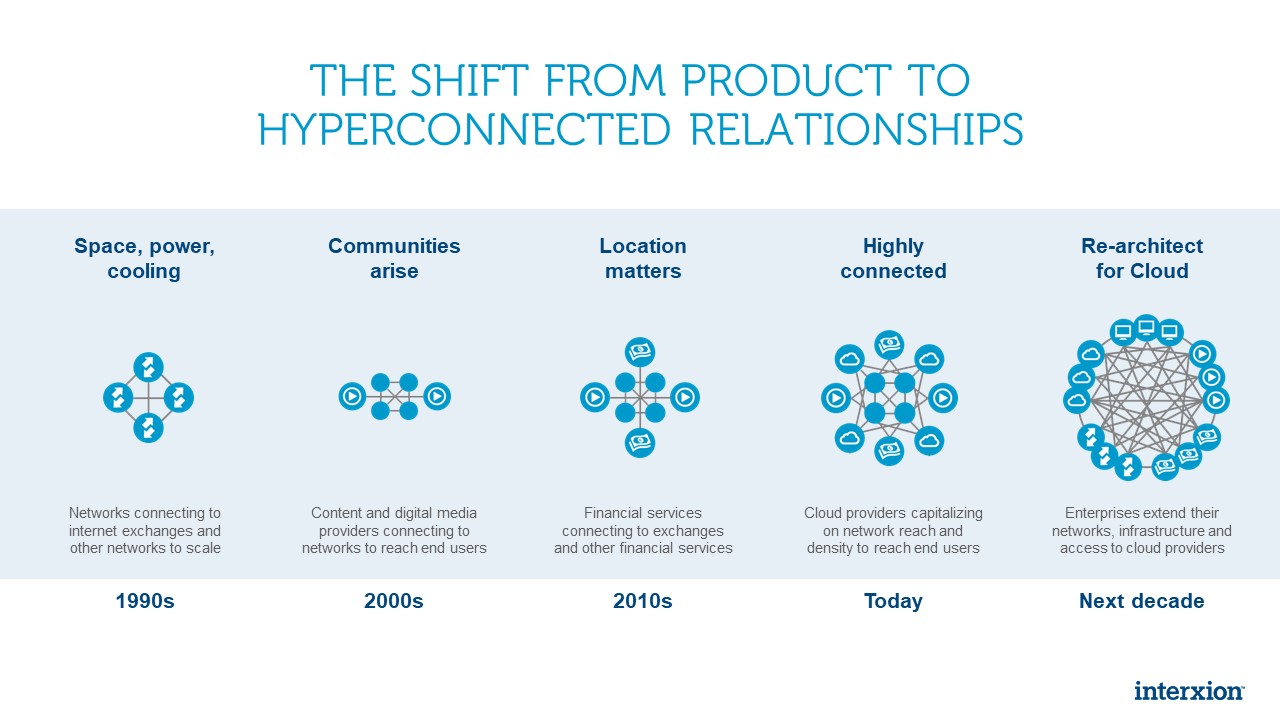By: Jelle Frank van der Zwet
The evolution of the data centre
In the not-too-distant-future, we will no longer talk about data centres as places primarily offering data and storage capabilities. In 2017, approximately eight million companies worldwide operated their IT environments locally, in their own data centres. But alongside these, a small number of neutral colocation data centres have surfaced, playing a crucial role in both global data traffic, and the digital transformation of many companies.

These hyperconnected cloud and carrier-neutral data centres, offering internet nodes and direct access to different cloud providers, are giving larger companies and IT service providers faster and more efficient communication. Linking together enterprise systems and data with networks, cloud providers, partners and platforms, they are becoming important meeting points – the world’s interconnectivity hubs.
Transformation through interconnectivity
Data centres are emerging as neutral hubs for data traffic, where switching points from many different cloud providers and network operators meet. With more and more companies embracing an IT model based on hybrid infrastructure, integration and interconnection between different systems and platforms now plays a much greater role. This means that hyperconnected data centres are now providing many organisations with opportunities to speed up their digital transformation.
In a hyperconnected hub, the benefits are not limited to just the proximity points of the cloud supplier’s infrastructure and several important internet nodes. It also provides close proximity to new collaborators and IT service providers, opening up opportunities for organisations to harness new technologies, streamline their operations, improve customer experiences and reduced their costs.
Colocation for performance
Historically, sectors with a critical need for fast communication have benefitted from being physically close to each other. One example of this is in financial services where high-frequency trading requires systems to be installed near the central trading platforms.
But with hyperconneced colocated data centres, sectors get the benefits of being geographically close to their market, while also safely and efficiently linking together on-premises systems to private and public clouds. Alongside this, private connection to the cloud opens up the possibility of connecting with major cloud suppliers, allowing the organisation to increase security, reliability and performance.
This means that now entire sectors such as banking, insurance, healthcare, retail, transportation and manufacturing are undergoing digital transformation as a way to become more competitive, and organisations will want to run their IT infrastructure side-by-side with the big cloud platforms to take advantage of the benefits of the public cloud without compromising their network performance.
As a result, and alongside an increasing need for critical operational systems to be housed in close proximity to cloud providers in order to solve network challenges, the demand for colocated and hyperconnected data centres is only set to rise.
Future-proofing the hybrid IT environment
Traditional IT architecture relies on a wide area network (WAN), where the organisation's own data centre acts as the hub where most of its applications and data are handled. But with the emergence of cloud services – where both customers and employees need access to business-critical applications through mobile devices – the WAN architecture has quickly become outdated.
Moving on-premises systems to a neutral data centre is the first step towards embracing future solutions, applications and services – solving the problem of older legacy systems holding back the organisation’s digitisation process. With a colocation solution, they can create a hybrid environment that meets the needs of their customers, while also reducing both the cost and complexity of the IT environment for their own service and delivery.
Next steps for transforming the hybrid IT environment
In order to make a data centre migration a strategic advantage for an organisation, the data centre needs to accommodate categories of IT and ISPs that can offer it high-performance and high-quality interconnectivity services, alongside fast response times and opportunities for collaboration and information sharing within a secure environment.
In doing so, we will make the hyperconnected data centre the cornerstone of the new digital economy, and with it help organisations to reap the full benefits of hybrid IT.
Want to know more?
Want to know more about how hybrid IT is changing the market landscape for service providers? Download our whitepaper: ‘Trends for European Hosters and Managed Service Providers’






